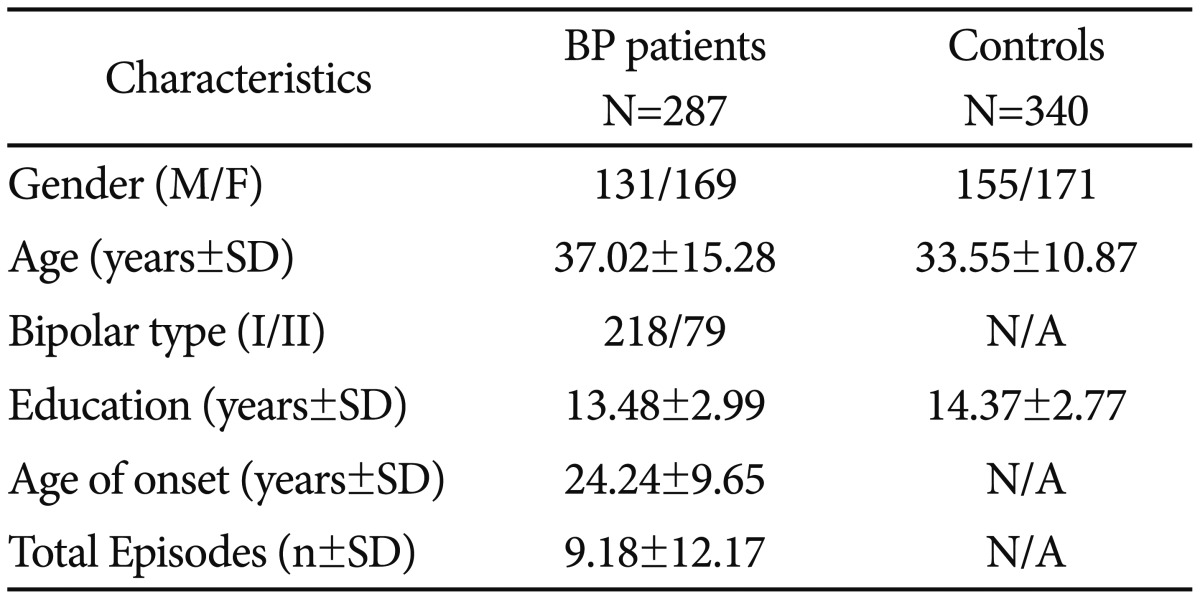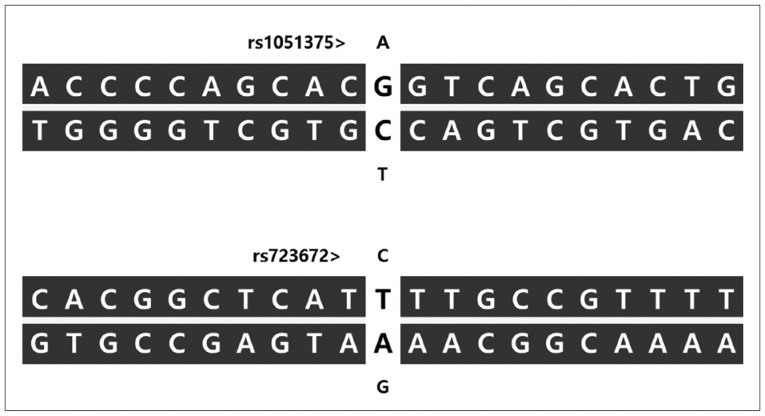Association of CACNA1C Variants with Bipolar Disorder in the Korean Population
Article information
Abstract
Objective
Previous studies have suggested an association between CACNA1C and susceptibility of bipolar disorder. In this study, we examined the association of CACNA1C variants with bipolar disorder in the Korean population.
Methods
We selected 2 CACNA1C single nucleotide polymorphisms (SNPs), namely, rs723672 and rs1051375, based on their functions and minor allele frequencies described in previous studies. Genotypes of these 2 SNPs were analyzed by extracting DNA from blood samples collected from 287 patients with bipolar disorder and 340 healthy controls.
Results
Genotype frequencies of both rs723672 and rs1051375 SNPs were significantly different in patients and controls (p=0.0462 and 1.732E-14, respectively). Dominant, recessive, and allele models showed significant differences between patients and controls with respect to the rs1051375 SNP (p=1.72E-11, 4.17E-10, 4.95E-16, respectively).
Conclusion
Our results suggested that CACNA1C SNPs rs723672 and rs1051375 were associated with bipolar disorder in the Korean population. In addition, our results highlighted the importance of CACNA1C in determining susceptibility to bipolar disorder.
INTRODUCTION
Bipolar disorder is a psychiatric disorder characterized by the repetition of extremely elevated mood, followed by mania and depression.12 In the manic state, patients exhibit symptoms such as hyperactivity, talkativeness, creativity, excessive self-esteem, and decreased sleep. Some patients also experience delusions or hallucinations.3 In the depressive state, patients experience hopelessness, anxiety, lethargy, sadness, and suicidal impulse4. Although the etiology of bipolar disorder is still unclear, twin and family studies have suggested that it is a complex genetic disorder,567 indicating that genetic factors are an important cause of bipolar disorder. Moreover, genome-wide association studies (GWAS) have indicated an association between bipolar disorder and single nucleotide polymorphisms (SNPs) in DGKH, BCR, TPH2, BDNF, ANK3, and CACNA1C.89101112
CACNA1C, which encodes the alpha-1 subunit of voltage-gated calcium channel CaV1.2, plays an important role in calcium ion influx into cells. Because calcium channels are essential components of various calcium-dependent processes such as gene expression regulation, programmed cell death, neurotransmitter release, and muscle contraction, studies have focused on CACNA1C as a candidate gene associated with various diseases, especially psychiatric diseases.13 Furthermore, increasing number of studies are being performed on CACNA1C because the alpha 1 subunit of L-type calcium channel is a target of all well-known calcium channel blockers such as benzothiazepines.14 Various GWAS, meta-analyses, and replication studies have repeatedly highlighted the association between CACNA1C SNPs and bipolar disorder.1215161718 For example, rs1006737, one of the most frequently studied CACNA1C SNP, is associated with affective personality traits, intracellular calcium homeostasis, and amygdala activity.192021
In the present study, we determined the association between CACNA1C SNPs rs723672 and rs1051375 and bipolar disorder in the Korean population to understand genetic causes underlying bipolar disorder.
METHODS
Study population
Patients with bipolar disorder
All patients who met DSM-IV-TR criteria for bipolar disorder type 1 or 2 were recruited from Korea University Hospital, Seoul, between March 2009 and August 2015. All the patients were ethnically homogeneous Koreans and were examined by trained psychiatrists by using the Korean version of Structured Clinical Interview for DSM-IV, leading to a diagnosis based on DSM-IV criteria.22 Written informed consent was obtained from each patient, and study protocols were approved by the Ethics Committee of the Korea University Hospital. None of the patients included in the study had significant comorbid neurological illnesses, mental retardation, or history of substance abuse.
Healthy controls
In all, 340 community-based healthy adults were recruited through a newspaper advertisement. The age of healthy controls ranged from 23 to 83 years. Absence of lifetime or current psychiatric disorders in healthy controls was confirmed by an experienced psychiatrist by using Mini-International Neuropsychiatric Interview. Subjects with a family history of substance abuse or major psychiatric disorders (e.g., schizophrenia or mood disorders) were excluded. All the healthy controls were unrelated Koreans who did not have any major medical problems and who lived in Seoul, Korea. Informed consent was obtained from all the healthy controls.
Genotyping
Blood samples (5–10 mL) from all the study subjects were collected in EDTA-coated tubes, and genomic DNA was extracted from leukocytes by using QIAamp Blood Kit (Qiagen, Germany). Genotyping was performed using high-resolution melting (HRM) curve analysis. PCR was performed using 96-well CFX96 Real-Time PCR System (Bio-Rad, Hercules, CA) in a 20-µL reaction mixture containing 1.5 µL genomic DNA as the template, 200 mM of each primer (CACNA1C rs723672: forward 5'-CACTTCTACAACCGCTCT-3' and reverse 5'-TCCAAGGAGGAGGAATACA-3'; CACNA1C rs1051375: forward 5'-CAACGCCAACATCAACAAC-3' and reverse 5'-GTCTCCTCCACTGTCTCC-3'), 1× SsoFast EvaGreen Supermix (Bio-Rad), and sterile H2O. Amplification protocol was as follows: initial denaturation at 98℃ for 3 min, followed by 39 cycles of denaturation at 98℃ for 10 s and annealing at 58℃ for 20 s. After an initial cycle of denaturation at 95℃ for 10 s and annealing at 65℃ for 10 s, melting curves were generated from 65℃ to 95℃, with increments of 0.3℃/cycle. Melting profiles were analyzed using Precision Melt Analysis Software (Bio-Rad).
DNA sequencing
Some PCR products were randomly selected for DNA sequencing. Amplicons containing SNPs were generated by performing PCR with AC1000 thermal cycler (Bio-Rad) in a 20-µL reaction mixture containing 1.0 µL genomic DNA as the template, 0.5 µM of each primer (CACNA1C rs723672: forward 5'-CGTGGAACTTGCTGTGGTTG-3' and reverse 5'-CGCTGAACGCTTCCAGATGT-3'; CACNA1C rs1051375: forward 5'-ACCCCTCCTTCTTGCCTACA-3' and reverse 5'-CTGCCAGGTCTGATCAAGGG-3'), AccuPower® PCR Premix (Bioneer, Daejeon, Korea), and sterile H2O. Amplification protocol was as follows: initial denaturation at 93℃ for 3 min, followed by 35 cycles of denaturation at 94℃ for 20 s, annealing at 55℃ for 30 s, and elongation at 72℃ for 30 s. PCR products were confirmed by performing electrophoresis on a 1.5% agarose gel (USB Corporation, Cleveland, OH, USA) and were sequenced using ABI 3730XL capillary sequencer (Applied Biosystems, Carlsbad, CA, USA) and BigDye® Terminator v3.1 Cycle Sequencing Kit.
Statistical analysis
Conformance with Hardy-Weinberg equilibrium was determined using chi-square (χ2) test for goodness of fit. Probability value of <0.05 was considered statistically significant. Power calculation was performed using G*Power 3.1.9 (Dusseldorf, Germany).23 In all, 429 samples (df=2) were required to detect an SNP of the effective size and power (80%). Statistical analyses were performed using SPSS 18.0 for Windows (SPSS Inc., Chicago, IL, USA) and SNPAlyze version 7 (Dynacom, Chiba, Japan).
RESULTS
Demographic data
Demographic information of patients with bipolar disorder and healthy controls is presented in Table 1. The study included 627 subjects, of which 287 were patients and 340 were healthy controls. Of the 287 patients, 131 were men and 169 were women, with an average age of 37.02 years. The mean age of disease onset among the patients was 24.24 years, and the average number of total episodes was 9.18. Of the 340 healthy controls, 155 were men and 171 were women, with an average age of 33.55 years (Table 1).
Genotype distribution and allele frequencies of rs723672 and rs1051375
Genotype distribution of rs723672 and rs1051375 is shown in Table 2. Genotype distribution of both rs723672 and rs1051375 followed the Hardy-Weinberg equilibrium. In patients with bipolar disorder, frequencies of rs723672 genotypes T/T, T/C, and C/C were 64.5%, 30.7%, and 4.9%, respectively, and frequencies of T and C alleles were 79.8% and 20.2%, respectively. In healthy controls, frequencies of rs723672 genotypes T/T, T/C, and C/C were 66.8%, 31.8%, and 1.5%, respectively, and frequencies of T and C alleles were 82.6% and 17.4%, respectively. Further, in patients with bipolar disorder, frequencies of rs1051375 genotypes A/A, A/G, and G/G were 41.5%, 43.2%, and 15.3%, respectively, and frequencies of A and G alleles were 63.1% and 36.9%, respectively. In healthy controls, frequencies of rs1051375 genotypes A/A, A/G, and G/G were 68.2%, 30.0%, and 1.8% and frequencies of A and G alleles were 83.2% and 16.8%, respectively.
Results of HRM analysis were validated by randomly selecting blood samples for direct sequencing. Results of direct sequencing were parallel to those of HRM analysis.
Genotype model showed statistically significant differences between patients with bipolar disorder and healthy controls with respect to the rs723672 and rs1051375 SNPs (pGeno=0.0462 and pGeno=1.732E-14, respectively). In addition, both recessive and dominant allele models showed statistically significant differences between patients with bipolar disorder and controls with respect to the rs1051375 SNP, indicating that the frequency of the A/G heterotype of the rs1051375 SNP was higher in patients with bipolar disorder than in controls (pRec=4.172E-10 and pDom=1.72E-11, respectively). More patients with bipolar disorder harbored the C allele of the rs723672 SNP than controls (pRec=0.0131) (Table 3).
DISCUSSION
As an L-type voltage-gated Ca2+ channel, CACNA1C contributes to the depolarization of neurons through calcium ion influx.24 Variations in SNPs in CACNA1C affect both the structure and function of the nervous system,25 including synaptic plasticity and neuron viability.13 Association of CACNA1C SNPs with Timothy syndrome, fear conditioning, major depression, and schizophrenia26272829 has been found, and correlation with bipolar disorder was also reported through GWAS study.12 The association between bipolar disorder and CACNA1C SNPs has been examined in Han Chinese population (HCP).30 However, only the association between schizophrenia and CACNA1C SNPs has been examined in the Korean population.31 Therefore, our study is the first to directly analyze the association between CACNA1C SNPs and bipolar disorder.
Although the genotype frequencies of rs1051375 in our control group showed statistically different frequencies compared to those observed in Han Chinese population (HCP) in the study by Zhang et al.,30 results of the present study and those of the previous study highlight the association between rs723672 SNP and bipolar disorder (pHCP=0.005 and pKOR=1.732E-14). In addition, unlike that observed in the HCP, we observed that the rs723672 SNP was associated with bipolar disorder (pHCP=0.30 and pKOR=0.0462).
However, further studies should be performed to determine the mechanisms underlying the effect of CACNA1C rs723672 and rs1051375 SNPs on the expression and function of the L-type voltage-gated Ca2+ channel. Particularly, the G allele, which is dominant in the rs1051375 SNP, creates a CpG site containing a cytosine nucleotide adjacent to a guanine nucleotide. Although the rs1051375 SNP does not directly affect the primary structure of the L-type voltage-gated Ca2+ channel, it may serve as a methylation site (Figure 1). Although it is unclear whether this CpG site undergoes methylation, a study showed that 70–80% cytosines in CpG sites of mammalian genomes are methylated.32 Therefore, it is highly likely that the rs1051375 SNP contributes to epigenetic regulation through the methylation of CACNA1C. Moreover, a study showed that DNA methylation pattern of CACNA1C is specific in neuronal cells, thus reinforcing that changes in methylation patterns of specific sites in CACNA1C can induce psychiatric disorders by modulating neuronal activity.
However, our study has some limitations. First, the average age of healthy controls was slightly lower than that of patients with bipolar disorder, suggesting that the healthy controls could develop bipolar disorder as they aged. Although this possibility bridged the difference between the 2 groups, a me-aningful difference was still observed in our study. Second, genotype distribution of the rs723672 SNP slightly deviated from the Hardy-Weinberg equilibrium in healthy controls. However, this deviation was very small to refute the assumption that the rs723672 SNP is underlying the Hardy-Weinberg equilibrium. These data were verified by performing repeated HRM analyses. Third, haplotype combinations were not analyzed because LD value was not significant between the rs723672 and rs1051375 SNPs (D'=-9.609E-3).
In conclusion, the results of our study suggested the association of CACNA1C rs723672 and rs1051375 SNPs with bipolar disorder in the Korean population, thus supporting the hypothesis that CACNA1C is involved in the pathogenesis of bipolar disorder. Our data together with those of other studies highlight an association between CACNA1C SNPs and bipolar disorder. these results will provide useful insights for performing further research to determine genetic causes underlying bipolar disorder.
Acknowledgments
This study was supported by the Korea Health 21 R&D Project funded by the National Research Foundation of Korea (2012M3A9C7050135) and the Korean Health Technology R&D Project, Ministry of Health & Welfare, Republic of Korea (HI14C1731).



